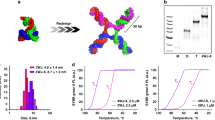Abstract
Purpose. To identify hydrotropic agents that can increase aqueous paclitaxel (PTX) solubility and to study the chemical structures necessary for hydrotropic properties so that polymeric hydrotropic agents can be synthesized.
Methods. More than 60 candidate hydrotropic agents (or hydro- tropes) were tested for their ability to increase the aqueous PTX solubility. A number of nicotinamide analogues were synthesized based on the observation that nicotinamide showed a favorable hydrotropic property. The identified hydrotropes for PTX were used to examine the structure-activity relationship.
Results. N,N-Diethylnicotinamide (NNDENA) was found to be the most effective hydrotropic agent for PTX. The aqueous PTX solubility was 39 mg/ml and 512 mg/ml at NNDENA concentrations of 3.5 M and 5.95 M, respectively. These values are 5-6 orders of magnitude greater than the intrinsic solubility of 0.30 ± 0.02 μg/ml. N-Picolylnicotinamide, N-allylnicotinamide, and sodium salicylate were also excellent hydrotropes for PTX. Solubility data showed that an effective hydrotropic agent should be highly water soluble while maintaining a hydrophobic segment.
Conclusions. The present study identified several hydrotropic agents effective for increasing aqueous solubility of PTX and analyzed the structural requirements for this hydrotropic property. This information can be used to find other hydrotropic compounds and to synthesize polymeric hydrotropes that are effective for PTX and other poorly water-soluble drugs.
Similar content being viewed by others
REFERENCES
S. H. Yalkowsky. Solubility and Solubilization in Aqueous Media, American Chemical Society, Washington, D.C., 1999.
R. Löbenberg, G. L. Amidon, and M. Vierira. Solubility as a limiting factor to drug absorption. In J. B. Dressman and H. Lennernäs (eds.), Oral Drug Absorption. Prediction and Assessment, Marcel Dekker, New York, 2000, pp. 137–153.
R. H. Müller and B. Böhm. Nanosuspensions. In R. H. Müller, S. Benita, and B. Böhm (eds.), Emulsions and Nanosuspensions for the Formulation of Poorly Soluble Drugs, Medpharm Scientific Publishers, Stuttgart, 1998, pp. 149–174.
B. R. Goldspiel. Clinical overview of the taxanes. Pharmacotherapy 17:110S-125S (1997).
R. Paradis and M. Page. New active paclitaxel amino acids derivatives with improved water solubility. Anticancer Res. 18:2711–2716 (1998).
S. Y. Leung, J. Jackson, H. Miyake, H. Burt, and M. E. Gleave. Polymeric micellar paclitaxel phosphorylates Bcl-2 and induces apoptotic regression of androgen-independent LNCaP prostate tumors. Prostate 44:156–163 (2000).
A. G. Floyd and S. Jain. Injectable emulsions and suspensions. In H. A. Lieberman, M. M. Rieger, and G. S. Banker (eds.), Pharmaceutical Dosage Forms: Disperse Systems, Vol. 2, Marcel Dekker, New York, 1998, pp. 261–318.
H. Alkan-Onyuksel, S. Ramakrishnan, H. B. Chai, and J. M. Pezzuto. A mixed micellar formulation suitable for the parenteral administration of taxol. Pharm. Res. 11:206–212 (1994).
J. L. Ford. The current status of solid dispersions. Pharm. Acta Helv. 61:69–88 (1986).
A. T. M. Serajuddin. Solid dispersion of poorly water-soluble drugs: Early promises, subsequent problems, and recent breakthroughs. J. Pharm. Sci. 88:1058–1066 (1999).
J. Rubino and S. Yalkowsky. Cosolvency and cosolvent polarity. Pharm. Res. 4:220–230 (1987).
R. E. Coffman and D. O. Kildsig. Hydrotropic solubilization-mechanistic studies. Pharm. Res. 13:1460–1463 (1996).
B. W. Müller and E. Albers. Effect of hydrotropic substances on the complexation of sparingly soluble drugs with cyclodextrin derivatives and the influence of cyclodextrin complexation on the pharmacokinetics of the drugs. J. Pharm. Sci. 80:599–604 (1991).
S. C. Lee, G. Acharya, J. Lee, and K. Park. Hydrotropic polymers: Synthesis and characterization of polymers containing picolylnicotinamide moieties. Macromolecules 36:2248–2255 (2003).
Author information
Authors and Affiliations
Corresponding author
Rights and permissions
About this article
Cite this article
Lee, J., Lee, S.C., Acharya, G. et al. Hydrotropic Solubilization of Paclitaxel: Analysis of Chemical Structures for Hydrotropic Property. Pharm Res 20, 1022–1030 (2003). https://doi.org/10.1023/A:1024458206032
Issue Date:
DOI: https://doi.org/10.1023/A:1024458206032




